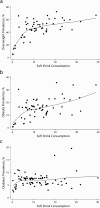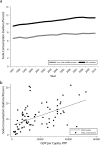Relationship of soft drink consumption to global overweight, obesity, and diabetes: a cross-national analysis of 75 countries
- PMID: 23488503
- PMCID: PMC3828681
- DOI: 10.2105/AJPH.2012.300974
Relationship of soft drink consumption to global overweight, obesity, and diabetes: a cross-national analysis of 75 countries
Abstract
Objectives: We estimated the relationship between soft drink consumption and obesity and diabetes worldwide.
Methods: We used multivariate linear regression to estimate the association between soft drink consumption and overweight, obesity, and diabetes prevalence in 75 countries, controlling for other foods (cereals, meats, fruits and vegetables, oils, and total calories), income, urbanization, and aging. Data were obtained from the Euromonitor Global Market Information Database, the World Health Organization, and the International Diabetes Federation. Bottled water consumption, which increased with per-capita income in parallel to soft drink consumption, served as a natural control group.
Results: Soft drink consumption increased globally from 9.5 gallons per person per year in 1997 to 11.4 gallons in 2010. A 1% rise in soft drink consumption was associated with an additional 4.8 overweight adults per 100 (adjusted B; 95% confidence interval [CI] = 3.1, 6.5), 2.3 obese adults per 100 (95% CI = 1.1, 3.5), and 0.3 adults with diabetes per 100 (95% CI = 0.1, 0.8). These findings remained robust in low- and middle-income countries.
Conclusions: Soft drink consumption is significantly linked to overweight, obesity, and diabetes worldwide, including in low- and middle-income countries.
Figures


References
-
- Danaei G, Finucane MM, Lu Yet al.National, regional, and global trends in fasting plasma glucose and diabetes prevalence since 1980: systematic analysis of health examination surveys and epidemiological studies with 370 country-years and 2.7 million participants. Lancet. 2011;378(9785):31–40 - PubMed
-
- International Diabetes Federation (IDF). IDF Diabetes Atlas. 2011. Available at: http://www.idf.org/diabetesatlas. Accessed October 10, 2011.
-
- World Health Organization. Global Database on Body Mass Index. 2011. Available at: http://apps.who.int/bmi/index.jsp?introPage=intro.html. Accessed October 10, 2011.
-
- Popkin BM. What is unique about the experience in lower- and middle-income less-industrialised countries compared with the very-high income countries? The shift in the stages of the nutrition transition differs from past experiences! Public Health Nutr. 2002;5(1A):205–214 - PubMed
-
- Popkin BM. Global nutrition dynamics: the world is shifting rapidly toward a diet linked with noncommunicable diseases. Am J Clin Nutr. 2006;84(2):289–298 - PubMed
MeSH terms
LinkOut - more resources
Full Text Sources
Other Literature Sources
Medical

